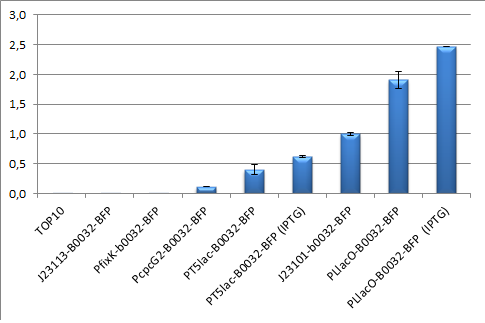Difference between revisions of "Part:BBa K592100:Experience"
(→Applications of BBa_K592100) |
|||
| Line 10: | Line 10: | ||
| + | |||
| + | <hr> | ||
| + | <p> | ||
| + | '''iGEM14_Carnegie_Mellon'''. | ||
| + | We characterized a set of fluorescent proteins consisting of BFP. GFP, YFP, OFP, and RFP. We calculated the signal-to-noise ratio of all the proteins in two different cell line (MACH and Top10). BFP had the lowest signal-to-noise ratio in both cell lines. BFP was measured at ex/em = 399nm/456nm. | ||
| + | </p> | ||
| + | https://static.igem.org/mediawiki/2014/thumb/c/c1/FP_MACH.png/591px-FP_MACH.png | ||
| + | https://static.igem.org/mediawiki/2014/thumb/9/9f/Top10_Best.jpg/591px-Top10_Best.jpg | ||
===User Reviews=== | ===User Reviews=== | ||
Revision as of 22:13, 17 October 2014
This experience page is provided so that any user may enter their experience using this part.
Please enter
how you used this part and how it worked out.
Applications of BBa_K592100
iGEM11_Uppsala-Sweden. BFP used as reporter. This part has been successfully used as a reporter gene for promoter characterization using flow cytometry. The excitation peak at 399 nm makes it well suited for use in flow cytometers using a 407 nm violet laser such as the FACSAria II, and the emission peak at 456 works well with a DAPI filter (band pass 450/40). The Y axis measures the promoter activity in RPU, relative promoter units, where the activity of the J23101 promoter is defined as 1 RPU.
iGEM14_Carnegie_Mellon. We characterized a set of fluorescent proteins consisting of BFP. GFP, YFP, OFP, and RFP. We calculated the signal-to-noise ratio of all the proteins in two different cell line (MACH and Top10). BFP had the lowest signal-to-noise ratio in both cell lines. BFP was measured at ex/em = 399nm/456nm.


User Reviews
UNIQba30517c2d1e95e7-partinfo-00000000-QINU UNIQba30517c2d1e95e7-partinfo-00000001-QINU

